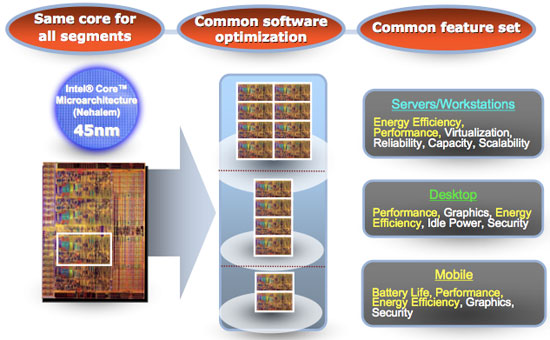The Dark Knight: Intel's Core i7
by Anand Lal Shimpi & Gary Key on November 3, 2008 12:00 AM EST- Posted in
- CPUs
Multiple Clock Domains
Functionally there are some basic differences between Nehalem and previous Intel architectures. The Front Side Bus is gone and replaced with Intel's Quick Path Interconnect, similar to AMD's Hyper Transport. The QPI implementation on the first Nehalem is a 25.6GB/s interface which matches up perfectly to the 25.6GB/s of memory bandwidth Nehalem has.
The CPU operates on a multiplier of the QPI source clock, which in this case is 133MHz. The top bin Nehalem runs at 3.2GHz or 133MHz x 24. The L3 cache and memory controller operate on a separate clock frequency called the un-core clock. This frequency is currently 20x the BCLK, or 2.66GHz.
This is all very similar to AMD's Phenom, but where the two differ is in how they handle power management. While AMD will allow individual cores to request different clock speeds, Nehalem attempts to run all of its cores at the same frequency; if one core is idle then it's simply power gated and the core is effectively turned off. I explain this in greater detail here but the end result is that we don't have the strange performance issues that sometimes appear with AMD's Cool'n'Quiet enabled. While we have to turn off CnQ to get repeatable results in some of our benchmarks (in some cases we'll see a 50% performance hit with CnQ enabled), Intel's EIST seems to be fine when turned on and does not concern us.
My Concern
Looking at Nehalem's microarchitecture one thing becomes very clear: this is a CPU designed to address Intel's shortcomings in the server space. There's nothing inherently wrong about that, but it's a different approach than what Intel did with Conroe. With Conroe Intel took a mobile architecture and using the philosophy that what was good for mobile, in terms of power efficiency and performance per watt, would also be good for the desktop, it created its current microarchitecture.
This was in stark contrast to how microprocessor development used to work; chips would be designed for the server/workstation/high end desktop market and trickle down to mainstream users and the mobile space. But Conroe changed all of that, it's a good part of why Intel's Core 2 architecture makes such a great desktop and mobile processor.
Power obviously also matters in servers but not to the same extent as notebooks, needless to say Conroe did well in the server market but it lacked some key features that allowed AMD to hang onto market share.
Nehalem started out as an architecture that addressed these enterprise shortcomings head on. The on-die memory controller, Hyper Threading, larger TLBs, improved virtualization performance, restructured cache hierarchy, the new 2nd level branch predictor, all of these features will be very important to making Intel more competitive in the enterprise space, but at what cost to desktop power consumption and performance?

Intel promises better energy efficiency for the desktop, we'll be the judge of that...
I'm stating the concern up front because when I approached today's Nehalem review that's what I had in mind. Everyone has high expectations for Nehalem, but it hasn't been that long since Intel dropped Prescott on us - what I want to find out is whether Intel has stayed true to its mission on keeping power in check or if we've simply regressed with Nehalem.
The only hope I had for Nehalem was that it was the first high performance desktop core that implemented Intel's new 2:1 performance:power ratio rule. Also used by the Atom's design team, every feature that made its way into Nehalem had to increase performance by 2% for every 1% increase in power consumption otherwise it wasn't allowed in the design. In the past Intel used a general 1:1 ratio between power and performance, but with Nehalem the standards were much higher. We'll find out if Intel was all talk in a moment, but let's take a look at Nehalem's biggest weakness first.










73 Comments
View All Comments
fzkl - Monday, November 3, 2008 - link
"Where Nehalem really succeeds however is in anything involving video encoding or 3D rendering"We have new CPU that does Video encoding and 3D Rendering really well while at the same time the GPU manufacturers are offloading these applications to the GPU.
The CPU Vs GPU debate heats up more.
_______________________________________________________________
www.topicbean.com
Griswold - Tuesday, November 4, 2008 - link
Wheres the product that offloads encoding to GPUs - all of them, from both makers - as a publicly available product? I havent seen that yet. Of course, we havent seen Core i7 in the wild yet either, but I bet it will be many moons before there is that single encoding suite that is ready for primetime regardless of the card that is sitting in your machine. On the other hand, I can encode my stuff right now with my current Intel or AMD products and will just move them over to the upcoming products without having to think about it.Huge difference. The debate isnt really a debate yet, if you're doing more than just talking about it.
haukionkannel - Monday, November 3, 2008 - link
Well if both CPU and GPU are better for video encoding, the better! Even now the rendering takes forever.So there is not any problem if GPU helps allready good 3d render CPU. Everything that gives more speed is just bonus!